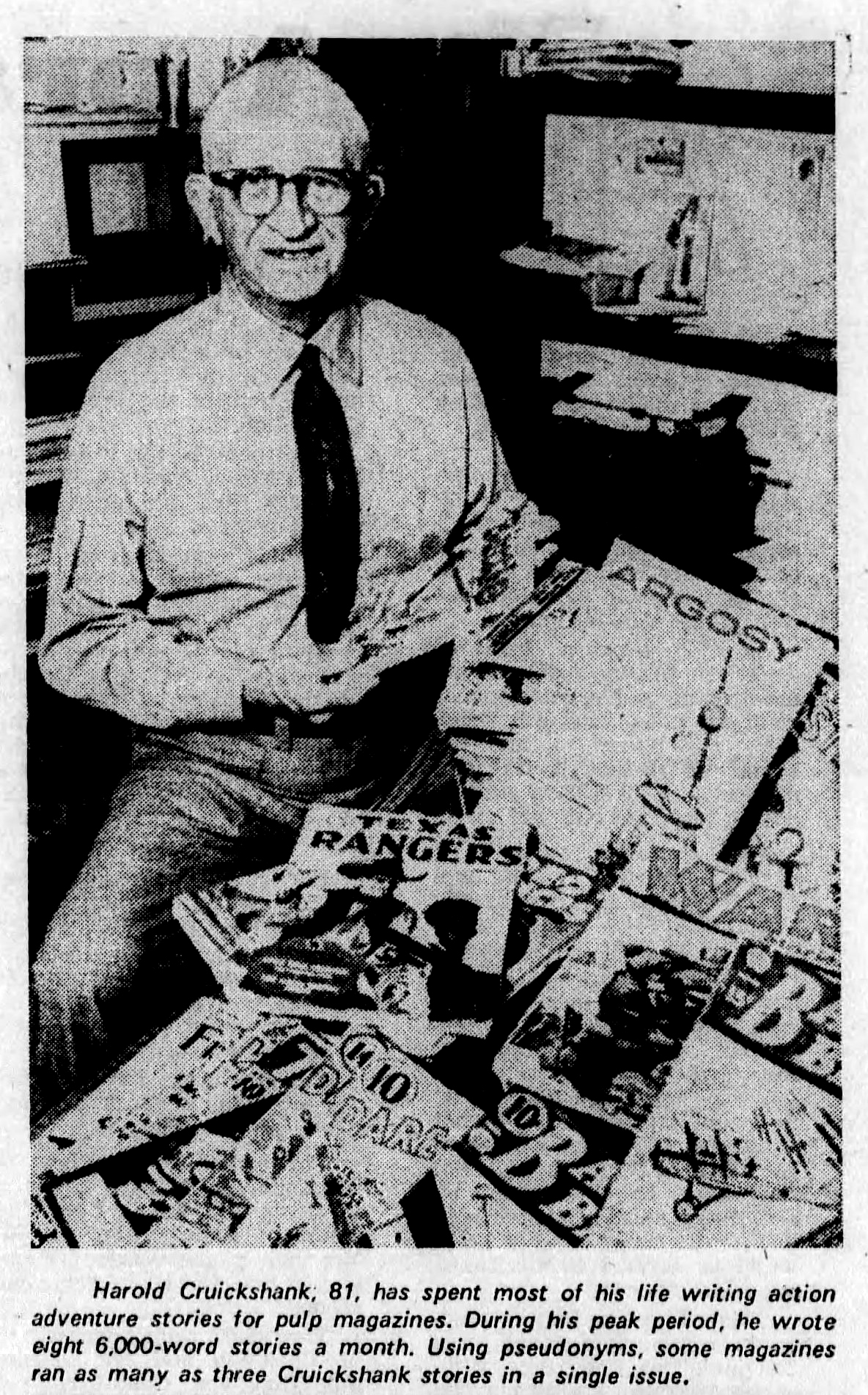Cruickshank’s Adventures in Pulps
THIS month we’re spotlighting the work of Canada’s favorite son, Harold F. Cruickshank. The following article from 1974 acts as a fine introduction to this prolific pulp author!
Adventures with Pulps
The Leader Post, Regina, Canada • 6 September 1974, p14

EDMONTON (CP) — Harold Cruickshank says a “green hungry monster’’ has swallowed up the kind of adventure literature he once wrote and peddled to pulp magazines.
Cruickshank, 81, has spent most of his life creating action-adventure heroes but says his brand of story has been replaced with “sex, violence, and pornography, the very things which we tried to keep from the eyes of our younger folk.â€
For 55 years Mr. Cruickshank, whose characters include the Sky Devil and Keko the wolf, wrote for pulp magazines, those publications printed on newsprint rather than fine paper.
During his peak he knocked off eight 6,000-word stories a month with titles like The Village of the Living Dead, Judgment of the War Gods and Where Death Lurks Deep.
Using pseudonyms, some magazines ran as many as three Cruickshank stories in a single issue.
“Certainly the pulps caried stories of violence, but it was a violence of a defensive nature.
“When we killed somebody it was because we knew damn well he was about to kill us, not out of any desire to kill.â€
Mr. Cruickshank’s war adventure stories were based on his own combat experience during two world wars.
His best-known war hero, First World War flying ace Capt. Bill Dawe, The Sky Devil, had a real life model in Mr. Cruickshank’s own infantry commander.
He said young readers who patterned themselves after heroes like the Sky Devil and formed fan clubs to honor the fictional adventurers were doing a good thing.
The pulp magazines such as Battle Stories, Dare-Devil Aces and Sky Fighters, popular between the 1920s and the early 1950s, sold for a quarter or less.
“The critics thought the pulps should be hidden under rocks and only read on rainy days,†said Mr. Cruickshank.
“Some of the greatest writers in the world wrote for the pulps. People who also wrote for the Saturday Evening Post, Colliers and Redbook.â€
“A writer for the pulp magazines had to be continually alert to cope with the changing trends. And you had to compete with the cream of the pulp people.
“When I first started off the demand was for war stories. When they faded you had to switch to air war stories.â€
When that fad passed a demand for wilderness adventure grew and Cruickshank met it with his profitable series about Keko the wolf.
The series jelled during the Depression when Mr. Cruickshank saw a German shepherd and a golden collie playing together in the snow.
“At that point I conceived in ray mind’s eye the product of a mating between a wolf and a collie.
“I developed this idea into a series of animal adventure stories running several years in one of the western magazines. I later compiled the stories into a book.**
Mr. Cruickshank launched his career when he was asked to write about his war comrades in Belgium in 1918.
He received a prize for a story and continued writing in his spare time in Alberta.
In 1923 he sold his first major piece to Western Home Monthly, Chatelaine’s forerunner, and a demand grew for his stories.
“For 55 years I wrote more magazine stories than most writers in the country, the U.S. and elsewhere and nobody cared.
“Now they come around giving me halos for what I’ve done. Not that I’m complaining, you understand, I always considered I was just doing a job, like a carpenter or anybody else.â€
Mr. Cruickshank now writes technical guides for would-be writers and instructional articles on homesteading for government publications.
![]()
The article above Is a combination of two versions of the same article. The one in The Regina Leader Post is the most complete version. The one in the Advocate is more edited, but includes the final paragraph.
- Download “Adventures with Pulp” (September 6, 1974, The Leader Post)
- Download “Heroes of pulp magazines replaced by sex, violence” (July 22, 1974, The Advocate)




